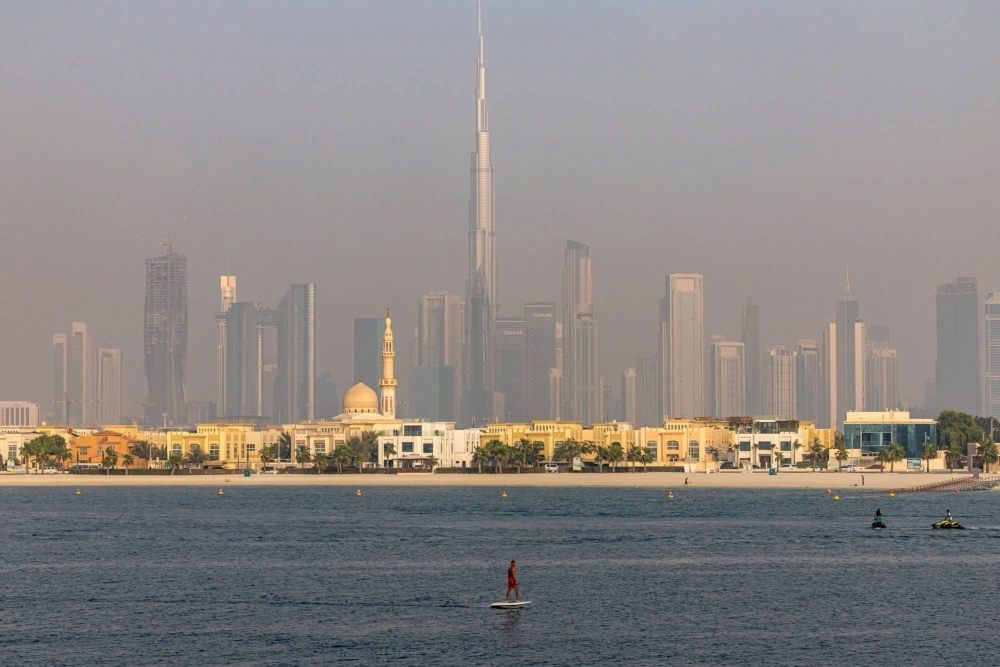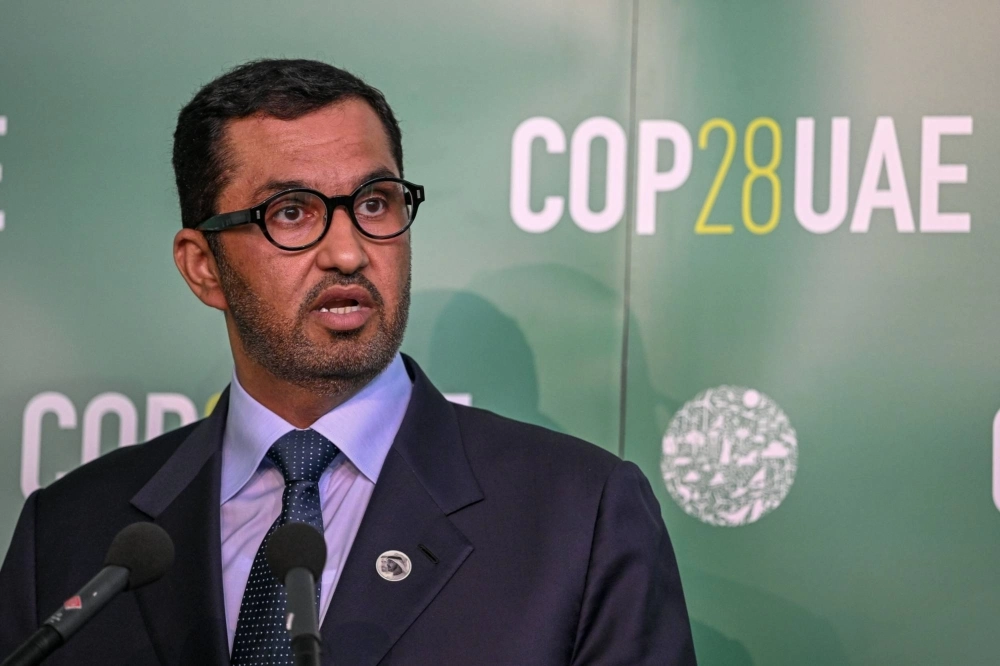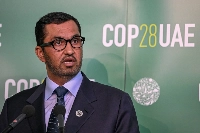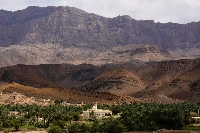The Hajar Mountains reach nearly 3,000 meters above sea level, tracing the coastline of Oman and the United Arab Emirates. Their arid peaks and valleys may seem desolate, but they could hold one of the keys to slowing global warming.
The range is home to one of the world’s largest deposits of olivine, a green mineral that a startup wants to extract, grind up and scatter along shorelines to absorb carbon dioxide from the atmosphere.
The world will need to remove billions of tons of carbon dioxide directly from the air each year by the middle of the century to avert the worst impacts of climate change. A growing number of startups are attempting to do so, using techniques that range from carbon-capturing machines to sequestering bio-oil underground. And some are turning to the ocean — which already absorbs about a quarter of all carbon dioxide emissions — as a potential solution, including San Francisco-based Vesta.
The firm wants to dump ground-up olivine on beaches and into seawater in an attempt to speed up the ocean’s natural ability to remove carbon dioxide. As the olivine dissolves in seawater, a chemical reaction occurs that pulls carbon dioxide from the air and eventually locks it up in the ocean in dissolved bicarbonate form. It’s one of a number of techniques known as enhanced rock weathering startups are testing on land and at sea.
Vesta has tested its technology on a beach in New York’s Hamptons, spreading olivine on the coast and mixing it with sand. But the startup has set its sights further afield for its next project, believing the Middle East may offer the best shot at capturing carbon dioxide cheaply and at scale.
"What we’re looking for is locations which have large amounts of the mineral and the right oceanographic conditions,” Tom Green, Vesta’s chief executive officer said. "When you look at the Middle East, you have both.”
It takes approximately one ton of olivine to remove one ton of carbon dioxide from the atmosphere, making securing access to a huge amount of the mineral critical to Vesta’s efforts, Green said. He believes Vesta’s solution has the potential to remove 1 billion tons of carbon dioxide a year by midcentury, in part because olivine is one of the world’s most abundant minerals. In his view, extracting the billion tons of olivine needed to reach that ambition "is large but feasible” given the scale of comparative mining industries like coal and limestone aggregate.
Vesta’s analysis has identified the Persian Gulf as an ideal location to deploy its technology due to the chemistry and high temperature of the waters as well as the types of currents, Green said. The waters of the Gulf are some of the warmest in the world, for example, which could make Vesta’s carbon removal process more efficient.
The deposits of olivine in the Hajar Mountains and established mining companies in Oman and the UAE could prove a boon to Vesta, Green said. The region is also no stranger to large-scale coastal projects, including the construction of islands. (Some of those projects have garnered criticism from environmental groups for damaging biodiversity and eroding the shoreline.)
"The equipment being used for that is the same and the techniques are similar to the work that we do,” Green said. Although he declined to name specific olivine suppliers and purchasers, Green said the startup plans to deploy olivine in the region within the next two years.
The UAE is a major proponent of carbon capture technologies as a solution to the climate crisis in part because it would allow the country to continue to pump oil and gas, the mainstay of its economy. State energy firm Abu Dhabi National Oil (Adnoc) is working on a $900 million project to build more than 40 million barrels of oil storage in caverns in the same stretch of mountains that could supply massive amounts of olivine.
"There’s clearly a desire to invest in carbon removal programs,” said Green of the UAE. "We had multiple potential stakeholders ask us, ‘how quickly can you scale this?’”
UAE officials are expected to vigorously push carbon capture as a climate solution at the United Nations COP28 summit starting in November, which Dubai will host. COP28 President Sultan Al Jaber — who also heads Adnoc — has said climate diplomacy should focus on phasing out emissions from oil and gas, leaving the door open for the continued use of fossil fuels coupled with carbon sequestration.
The stance is at odds with EU and U.S. diplomats as well as the best available science, which shows the need to wind down the use of fossil fuels in the coming decades to avert catastrophic damage to the climate. While the world will likely need to remove billions of tons of carbon dioxide from the air in the coming decades, research indicates those efforts should be focused on intractable emissions from sources such as heavy industry and aviation.
Two major hurdles the carbon removal industry faces are high costs and energy use. Techniques to remove carbon from the atmosphere run into the hundreds or even thousands of dollars per ton. Vesta says its approach could cost as little as $21 and require 40 kilowatt-hours of energy to remove a ton of carbon dioxide, though Green declined to say the current cost of Vesta’s services. A 2022 report from the National Academy of Sciences estimated that the likely cost to deploy this and similar techniques in the coming decades ranges from $100 to $150 per ton of carbon dioxide.
There are also a number of other issues with seeding the ocean with olivine, including questions over how much the mineral can speed up carbon dioxide sequestration. Peter Kelemen, a professor of geochemistry at Columbia Climate School’s Lamont-Doherty Earth Observatory, estimated the process of olivine dissolution has a half life of about 70 years, meaning that it would take 70 years for half of the olivine deposited to dissolve and remove carbon dioxide in the process. He added that "the uncertainties are big.” For its part, Vesta says it is targeting a half life of about 10 to 20 years, owing to high water temperatures, wave action and how finely the olivine sand is ground.
Taking accurate measurements of how much carbon dioxide has been removed from the atmosphere is also a challenge. Vesta has deployed custom hardware on the seabed of its Hamptons pilot site that measures variables like alkalinity and dissolved inorganic carbon, which it says allow it to model how much carbon was removed.
"With a rock, especially when it’s so dispersed over a beach, you have no idea how quickly this stuff is dissolving,” said David Ho, a professor in the University of Hawaii at Manoa’s oceanography department.
The impact on ecosystems of lacing coastlines with olivine is also largely unknown. Organisms that live in the sand could find it challenging to live in that kind of environment, and olivine often contains toxic metals like nickel and chromium. If the olivine is ground very fine, its presence could impact small critters at the bottom of the food chain by blocking light, said Kate Moran, the chief executive officer and president of Ocean Networks Canada, an organization that monitors ocean health. That could ripple upwards, having unintended consequences. In addition, measuring the ecological impact of making the ocean more alkaline is "challenging,” she said.
To monitor its ecological impact, Vesta has been comparing the water quality and species abundance and diversity at its Hamptons site with control areas on either side. The startup has so far found "no adverse ecological effect whatsoever” at its pilot beach, Green said. The company also did a study placing oysters — which bioaccumulate heavy metals - in both areas, and found no difference between the two oyster populations.
Adding olivine to the oceans could be beneficial to the ocean, Green said, because it can help combat ocean acidification, which has decimated certain types of marine life. Yet many unknowns remain about the impact such a large human intervention could have on ocean ecosystems. Still, Green views the seas as a key avenue to put the brakes on global warming.
"Because we’re sort of terrestrial creatures, we have a terrestrial bias,” he said. "But, actually, the ocean presents the largest potential opportunity for carbon removal.”























With your current subscription plan you can comment on stories. However, before writing your first comment, please create a display name in the Profile section of your subscriber account page.